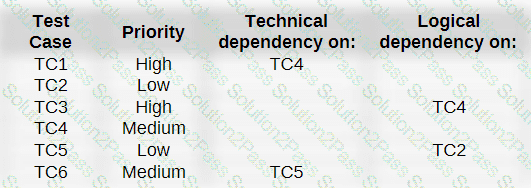ISTQB-CTFL ISTQB Certified Tester Foundation Level (CTFL v4.0) Free Practice Exam Questions (2025 Updated)
Prepare effectively for your ISTQB ISTQB-CTFL ISTQB Certified Tester Foundation Level (CTFL v4.0) certification with our extensive collection of free, high-quality practice questions. Each question is designed to mirror the actual exam format and objectives, complete with comprehensive answers and detailed explanations. Our materials are regularly updated for 2025, ensuring you have the most current resources to build confidence and succeed on your first attempt.
A class grade application for instructors assigns letter grades based on students' numerical grades.
The letter grades for different numerical grades should be:
Above 89, up to 100 - A
Above 79, up to 89 • B
Above 69, up to 79 • C
Above 59, up to 69 - D
Below 60- F
Which of the following sets of test inputs would achieve the relatively highest equivalence partition coverage?
Given the following examples of entry and exit criteria:
1.A defined level of code coverage has been achieved
2.The test automation tool has been installed and properly configured
3.The number of unresolved defects is within the predefined limit
4.The performance test environment has been set-up and is available
5.The user stories have proper acceptance criteria defined
6.The testing budget has been spent and the project sponsor bears the risk of not testing any further
Which of the following BEST categorizes them as entry and exit criteria:
Which of the following statements about testware are correct?
I When closing the test activities, all the testware resources can be uninstalled and released
II All the testware should be subject to Configuration Management
III. The testware. at the end of the project, should be transferred to the organization responsible for maintenance
IV The developers are responsible for the correct installation of the testware
Which of the following statements about static testing and dynamic testing is TRUE?
Which test level aims to gain the users' confidence in the system, especially in the fulfillment of the system's operational and performance capabilities?
Which of the following tools is most likely to detect defects in functions or methods in source code?
Which ONE of the following options is NOT a test objective?
Which of the following statements about the testing quadrants is TRUE?
Which of the following BEST describes a test summary report for executive-level employees
To be able to define testable acceptance criteria, specific topics need to be addressed. In the table below are the topics matched to an incorrect description. Match the topics (the left column) with the correct description (the right column)
TopicDescription
Calculate the measurement error SD for the following estimates done using three point estimation technique-Most optimistic effort (a) -120 person days Most likely effort (m) -180 person days Most pessimistic effort (b) - 240 person days
The tests at the bottom layer of the test pyramid:
Which ONE of the following options CANNOT be subjected to static analysis?
Which of the following is NOT an objective of testing?
Which of the following activities is NOT a pan of the fundamental testing process?
What does configuration management enable for testing?
Which of the following BEST matches the descriptions with the different categories of test techniques?
1.Test cases are based on the test basis which may include the requirements, use cases and user stories
2.Test cases are based on the test basis which may include the software architecture or code
3.Test cases can show deviations from the requirements
4.These test techniques are applicable to both functional and non-functional testing
5.Tests are based on knowledge of developers, users and other stakeholders
Black - Black-box test techniques
White * White-box test techniques
Experience - Experience-based test techniques
Which of the following statements about estimation of the test effort is WRONG?
Given the following priorities and dependencies for these test cases:

Which of the following test execution schedules BEST takes into account the priorities and technical and logical dependencies?
Which of the following statements about impact of DevOps on testing is CORRECT?

